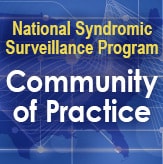New to Syndromic Surveillance?
Syndromic data are captured in nearly real time, which is particularly helpful for assessing the public’s health at any given time or for monitoring specific conditions (e.g., asthma, influenza-like illness). Syndromic surveillance can help you recognize an emerging environmental hazard that affects public health (such as respiratory problems from a chemical spill) and can also help you identify illness before diagnoses are confirmed and reported.
Because of the immediacy of syndromic data, you’ll need a strong understanding of what these data represent so that your interpretation is accurate. You’ll also need to understand the strengths and limitations of syndromic surveillance before integrating it fully into daily practice.
The resources listed below will help you gain a better understanding of syndromic surveillance.
These job aids bring together some of the “best of” resources developed by NSSP and the community:
- Query Development: Community and Technical Resources takes you step-by-step through the collaborative process of developing and testing queries (syndrome definitions).
- The Ultimate Guide for Site Administrators suggests ways to connect with peers, exchange technical solutions quickly, and points to all things NSSP.
Syndromic Surveillance
- What is Syndromic Surveillance?
- Centers for Disease Control and Prevention. Overview of Syndromic Surveillance. What is Syndromic Surveillance? MMWR 2004;53(Suppl);5–11.
- Centers for Disease Control and Prevention. Syndromic Surveillance on the Epidemiologist’s Desktop: Making Sense of Much Data; Figure 1, Theoretical framework for response protocols in use of syndromic surveillance systems. MMWR 2005;54(Suppl);141–6.
- NSSP and How We Conduct Syndromic Surveillance

We recommend that anyone new to syndromic surveillance join NSSP’s long-established Community of Practice (CoP). The NSSP CoP is a thriving community of people passionate about public health and syndromic surveillance.
Members range from epidemiologists conducting analyses for the first time in a real-world public health environment to experts in public health surveillance. To jump start your learning experience, take advantage of the NSSP CoP’s expert presentations and opportunities to collaborate with leaders in analytics, surveillance, informatics, and more.
Visit the NSSP CoP website, check out the New Member Orientation recording and call calendar, and peruse the extensive Knowledge Repository for resources. A high-level peek at all NSSP resources can be found here: Syndromic Surveillance Training Resources.
- Training Resources

Introduction to Syndromic Surveillance Methodology—NSSP represents a strategy to integrate near-real–time data with other data sources, connecting healthcare with public health. This curriculum-based, on-demand training series explains how to use near-real–time data, conceptualize new data applications, and act confidently on analyses. NSSP CoP members can access and complete the training for free: create a CSTE Learn account, click “sign up” on home page, register and click “submit.” Once registered, the training can be found here.
- Syndromic Surveillance 101: Introductory Course in Syndromic Surveillance
- Syndromic Surveillance 101: Introductory to R for Health Surveillance
- Using Syndromic Surveillance
- Syndromic Surveillance in Action: NSSP Success Stories
- Boston Public Health Commission – Syndromic Surveillance (YouTube video)
- Heffernan R, Mostashari F, Das D, Karpati A, Kulldorff M, Weiss D, et al. Syndromic Surveillance in Public Health Practice, New York City. Emerg Infect Dis. 2004;10(5):858–64. Available from: wwwnc.cdc.gov/eid/article/10/5/03-0646_article
Tools for Monitoring, Analyzing, and Responding to Syndromic Surveillance Data
- What is ESSENCE?
- NSSP-ESSENCE Resources
- ESSENCE Online Training Course
- NSSP ESSENCE 101 Training, 2021 (Vimeo video)
- NSSP ESSENCE 101 Training, 2020 (Vimeo video)
- Jurisdictional ESSENCE User Guides
- ESSENCE User Guide [Internet]. Version 1.0. Florida Department of Health, Bureau of Epidemiology. 2010. Appendix 1: Flowchart for analysis and response to syndromic surveillance data; [cited 2016 Nov 22]. p. 56. Available from www.floridahealth.gov/diseases-and-conditions/disease-reporting-and-management/disease-reporting-and-surveillance/_documents/florida-essence-user-guide.pdf
- NSSP-R Resources
- How to Use the ESSENCE APIs with the Rnssp Package
- NSSP R Training Part 1, 2021 (Vimeo video)
- NSSP R Training Part 2, 2021 (Vimeo video)
- International Society for Disease Surveillance (ISDS) Recommendations on Core Processes and EHR Requirements for Public Health Syndromic Surveillance, 2011
